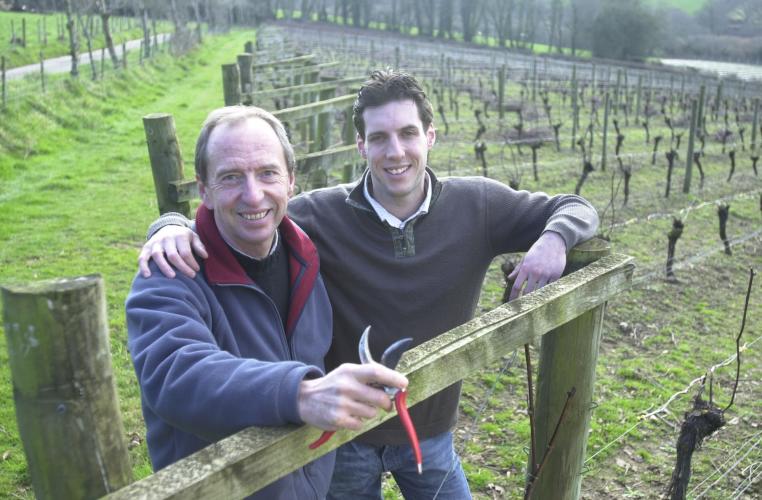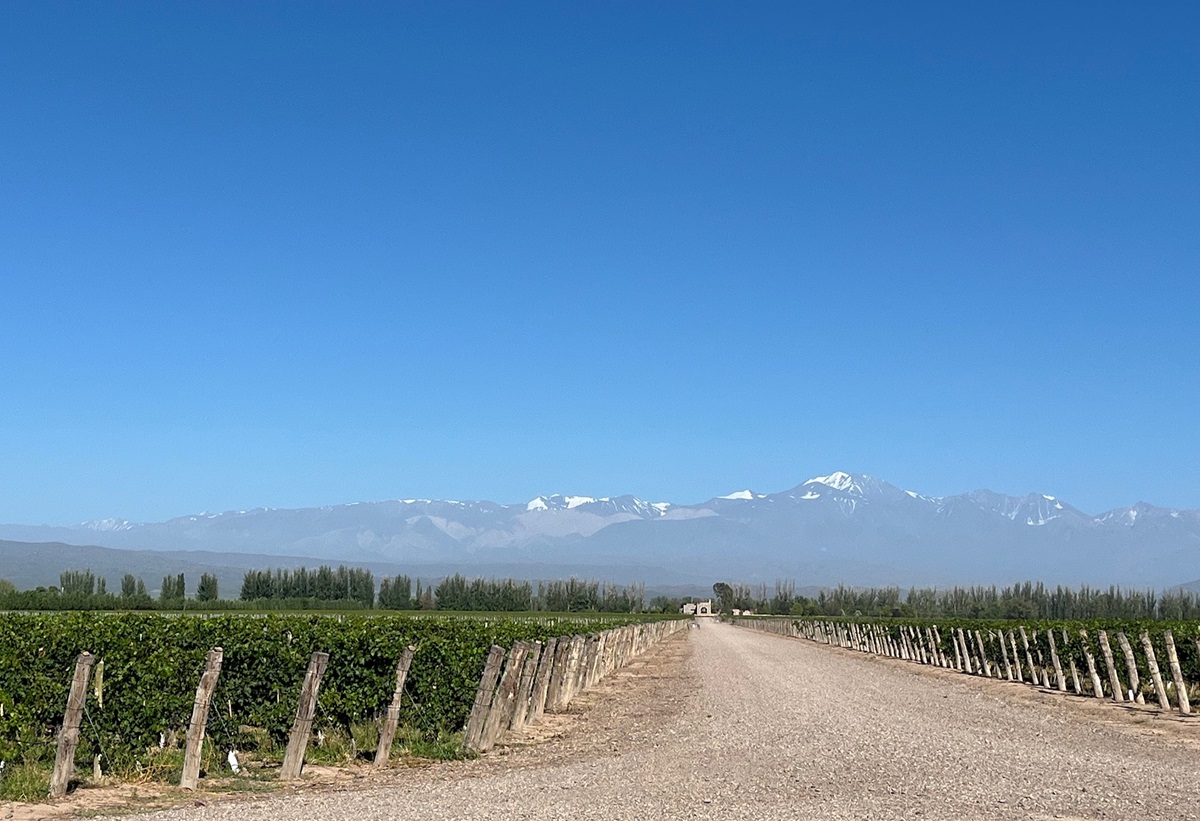A VISIT TO CAMEL VALLEY

by Rose Murray Brown MW
(Published in The Scotsman 31 August 2013)
I am standing just 120 feet above sea-level midway between the Atlantic and south coasts in the heart of Cornwall. The steep south facing slopes in this narrow sheltered valley have been used for sheep grazing for centuries. Today, there are 24,000 vines growing here in one of Britain’s most successful vineyards.
“We bought a farm in Cornwall back in 1982, because that was the cheapest place to buy one”, says Suffolk-born Bob Lindo (pictured above with son Sam Lindo and below with HRH Camilla). “We never bought it with the intention of planting vines, we just intended to raise life stock”, he says
After training as an engineer and working as an RAF pilot, a mid-air collision in this 30’s left Lindo with his back broken in three places. His serious spinal injury, which left him unable to walk for a while, convinced him and his wife Annie to look for a different lifestyle. The 82 acre farm near Bodmin was remote and rundown, but they decided to make a go of it. They renovated the farmhouse and buildings – and even laid a mile of concrete for a road into the property themselves.
“Each year we would see the grass on the slopes in front of our house turn brown in the summer and we wondered whether it might be possible to ripen grapes here”, says Lindo. “We planted our first vines in 1989 just for fun to see if they might work. Our neighbours thought we were mad digging 8000 holes to put vines in, but the first Seyval Blanc and Reichensteiner vines flourished on the ancient slate soils”, he says.
To learn the basics, Lindo worked a vintage in Germany, attended an eight day vineyard management course with UK viticultural expert Gillian Pearkes and visited English vineyards like Pilton Manor – but the rest he and his wife Annie learnt from first-hand experience. He admits that they made every mistake in the book and recounts amusing tales of their many problems, including bottles re-fermenting unexpectedly.
“We literally did everything by hand ourselves from planting, pruning, picking, winemaking, bottling to selling the wines – it was hard work with just two of us constantly working out in the vineyard and at harvest I was up all night crushing grapes”, says Lindo.
“When we started making sparkling wines, we didn’t have the money for sophisticated equipment, with only a small farming grant to buy presses”, he says. He recounts tales of the kind of equipment he started with. He rewired an old Curry’s freezer to help him freeze the yeasts in the sparkling wine bottles after second fermentation, he used a sheep’s syringe to test fizz pressures and old pliers to attach the wire over corks.
Today 75% of Camel Valley’s production is sparkling – and the winery is as impressive as anything you would see at top fizz producers elsewhere with a new press, fermenting vats, gyropalettes to help riddling the yeasts to the necks of the bottles – and even his own disgorging and bottling machine (“which cost more than the farm”). All are solar-powered.
Growing vines is never easy. Wherever you are in the world, there are plenty of hazards from hail in Bordeaux to baboons stealing grapes in the Western Cape. In Cornwall, Lindo’s biggest pests are the badgers and birds which love eating his grapes.
“We can manage these by putting up electric fences to stop badgers and we cover the vines with huge nets to stop the birds”, he says. “But our the biggest hazard is poor weather, particularly at flowering time which determines the size and quality of the crop”.
Frost is also a threat in these northerly vineyards. In the early days he and his wife Annie would stay up all night trying everything from lighting fires in the vineyards to spraying the vines to protect the buds, but it just made them cross and tired from lack of sleep – and didn’t really help the vines much.
Last year’s vintage 2012 was a washout for English winemakers. Constant torrential rain meant that some vines didn’t even bear any fruit. The Lindos only made 20,000 bottles. This year is looking more promising despite a cold start, as the glorious sunny summer weather and warm days are ripening Camel Valley’s grapes well. Lindo reckons the 2013 harvest will be mid-October and hopes to make 80,000 to 100,000 bottles.
Lindo’s son Sam, a maths graduate, is now winemaker. Destined for a career in the city, he decided he preferred the idea of running the family farm. He trained as winemaker in New Zealand with Kim Crawford and returned with fresh new ideas, introducing a new cold ferment regime. He has won UK Winemaker of the Year three times with trophies and awards now flooding in to Camel Valley for their fizz – which is even exported to Japan and Korea.
Judging from the quality of their sparkling wine compared to the still wines, I reckon this is where they will expand – but father Bob emphasises that despite using the same Pinot Noir and Chardonnay grapes as in Champagne, the same traditional method for making fizz and even winning medals over Roederer and Bollinger – they are not the same as Champagne.
“We are not trying to be look-alikes, we want to make something distinctively different here emphasising the floral aromas and delicate flavours that we get in Britain”, he says. “That is why I like using grapes like Seyval Blanc which grows so well here”.
Today Camel Valley is the biggest of three Cornish vineyards (Beuse and Knightor vineyards are based on the south coast near St Austell).
There is still room for expansion, if the Lindos are daring enough. They have another 58 acres currently rented out for grazing to a neighbour, whose grandson now works as their vineyard manager. “I am keen to try it”, says Lindo, “but the land is higher with more risk of frost and less sun”.
SPARKLING WINE
CORNWALL BRUT 2011
(£22.95 – £24.95 Waitrose; www.camelvalley.com)
After a walk on a windswept beach, there is nothing better than this delicate floral fizz made from Seyval Blanc, Reichensteiner and a little Chardonnay: it tastes very different from Champagne.
CORNWALL BRUT ROSE 2011
(£26.95 www.camelvalley.com)
More depth and complexity in this pale pink strawberry toned fizz, one of my favourites. Made from the classic Pinot Noir grape.
WHITE PINOT NOIR SPARKLING 2010
(£29.95 Waitrose; www.camelvalley.com)
My clear favourite in the line-up: lovely citric fruits, sweet undertones, long succulent length made from Pinot Noir: Lindo’s best. STAR BUY
ANNIE’S ANNIVERSARY BRUT 2010
(£24.95 www.camelvalley.com)
Made in honour of Annie Lindo who has personally pruned over 100,000 times in this single vineyard: one of the few vineyards in the world exclusively tended by one person. A floral smooth tribute to her hard graft.
STILL WINE
BACCHUS DRY 2012
(£12.95 www.camelvalley.com)
Light soft fragrant and dry with a surprising 13% alcohol: pricey.
PINOT NOIR ROSE 2012
(£11.95 www.camelvalley.com)
Another delicate dry very quaffable rose; sold in Fortnums in their hampers.
All wines above are available from www.camelvalley.com
Visit Camel Valley Vineyards on a Grand Tour or Guided Tour : telephone 01208 77959
wine tastings
The perfect gift for the wine enthusiast in the family. Rose does In-person tastings too.
cellar advice
Rose does cellar valuations for private clients, valuations for insurers & bespoke portfolio management.
Related stories
March 31, 2024
By Rose Murray Brown MW Published in The Scotsman 30 March 2024 On 2 February 1659, the first wine made from grapes grown in South Africa was crafted by the Governor of the Cape, Jan van Riebeeck. He had planted vines four years earlier in the Company’s Garden near Cape Town from cuttings imported from France. Van Riebeeck’s first
March 24, 2024
By Rose Murray Brown MW Published in The Scotsman 16 March 2024 Heatwaves and bushfires were very much on the agenda when I visited Chile last month as winemakers prepared for their 2024 harvest in blistering heat and drought, with a plume of smoke from the devastating fires lingering over coastal hills. Heat and drought are the greatest challenges
March 23, 2024
By Rose Murray Brown MW Published in The Scotsman 9 March 2024 I have two glasses of Malbec in my hands from the same high-altitude vineyard in Uco valley in Argentina. I am in the Catena Institute of Wine in Mendoza with winemaker Agustin Silva. He has asked me to taste the two wines, both from the 1500m high



